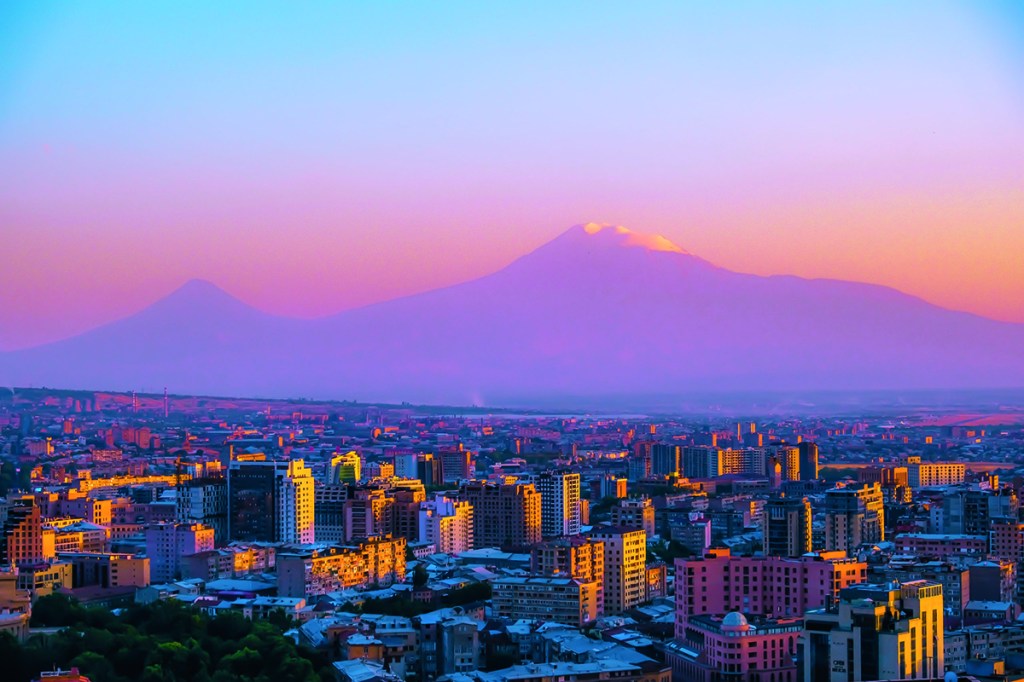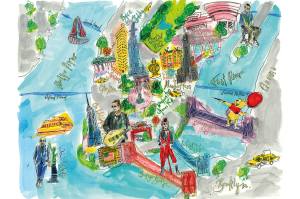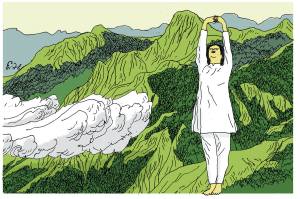The Iranians, here for the booze and the vaccine, are impossible to miss. But Armenians reminisce that, only a few years ago, you couldn’t throw a stone in Yerevan, their zestful, rhubarb-hued capital, without injuring a Californian or a New Yorker. Americans, they say, used to be ubiquitous in Armenia. This is a claim animated more by nostalgia than fact. The truth is, even prior to the pandemic and last autumn’s horrific war with Azerbaijan and Turkey, Americans accounted for only a fraction of the tourists who flocked to Armenia: in 2019, only 63,000 among the nearly two million foreign tourists, and a majority of those members of the Armenian diaspora.
I mention this to say that Americans really are missing out. Despite its celebrated daughters the Kardashians, Armenia is a well-kept secret. Those contemplating a post-pandemic pilgrimage to the edge of Europe and beyond should consider adding the world’s oldest Christian state to their itineraries. Yerevan is a living palimpsest of history and fable, so antique that Armenian folklore dates its genesis to the arrival of Noah, who, opening his eyes as the flood receded, is said to have exclaimed with rapture, Yerevats: ‘Land has appeared.’ You can be skeptical about this pious tale and still be awed by the grandeur of Armenia’s antiquity.
Yerevan cemented its position as a center of civilization and commerce almost 3,000 years ago. At the summit of their power, its rulers presided over a territory stretching from the southern and central coasts of the Black Sea to the Caspian Sea, and from the Mediterranean to Lake Urmia in today’s Iran. Rising rapidly, Armenia became a casualty of its own success. Repeatedly stormed, seized, pillaged and reduced by a swarm of empires (Roman, Persian, Arab, Ottoman, Russian), it fell under foreign domination by the 14th century. Not until the early 20th century, and after the genocide of 1.5 million Armenians by their Ottoman overlords, did Armenia regain its autonomy — briefly, and in a diminished portion of land.
Long experience of foreign rule has endowed Armenians with formidable gifts for adaptability and survival. Which explains why their way of life was able to survive seven decades of stifling Soviet rule. Today, Yerevan, which was razed and rebuilt in the aftermath of the Red Army’s invasion as a model Soviet city, is again leading Armenia’s national revival. War and disease have slowed down, though not suspended, Yerevan’s effort to affirm its status as a modern hub of culture, education and commerce in the Caucasus. The streets echo with the languages of Europe, West Asia and beyond: Russian, Georgian, Farsi, Arabic — and English in the singsong lilt of South Asia.
In the past, well-heeled American tourists used to complain about the scarcity of suitable accommodation. The advent of the Alexander, a plush hotel of 114 lavishly outfitted rooms set behind a Soviet façade on Abovyan Street — Yerevan’s Fifth Avenue, if you will — goes a great distance toward plugging the gap. Its proprietors have lured Michael Koltes — a longtime manager of multinational luxury properties in Asia, and something of a luminary in the business — to Yerevan, and he has rewarded them by instituting standards of hospitality that are, in the words of an elated American tech entrepreneur I met, ‘on par with anything in western Europe’.
Yerevan’s best restaurants, cafés and cultural institutions are all clustered in its compact center. A stone’s throw from Abovyan, on Pushkin Street, is Dolmama, the city’s most revered dining establishment. Its founder, Jirair Avanian, used to be a gallerist in Manhattan before impulsively deciding in the 1990s to return and start a restaurant. He sources the fish from Lake Sevan and the fruit and vegetables from Armenia’s hypnotically beautiful highlands. His pioneering farm-to-table philosophy has since made Dolmama, set inside one of Yerevan’s few remaining pre-Soviet buildings, something of a national institution. Boris Yeltsin, Hillary Clinton, George Clooney, Kanye West and Charles Aznavour (a French Armenian) have numbered among Dolmama’s diners.
A short distance from Dolmama, refugees from Syria, granted a warm welcome by Armenia, are reinventing Armenian cuisine with spices and culinary techniques drawn from Aleppo. To the north of Pushkin Street, on Freedom Square, is the magnificent Yerevan Opera Theater, home of the National Philharmonic Orchestra. To its south, in the capital’s administrative heart of Republic Square, is Armenia’s prodigious national museum. And a 50-minute drive from Yerevan into the foothills of the Geghama mountains leads to the Geghard monastery. Founded in the 4th century by Gregory the Illuminator, who converted of Armenia to Christianity in 301, the monastery is carved from the mountain and framed by towering cliffs. It is, like Armenia itself, a marvel to behold. I did not spot a single American among the worshippers.
Kapil Komireddi was a guest of the Alexander, Yerevan, a Luxury Collection hotel. This article was originally published in The Spectator’s October 2021 World edition.





















